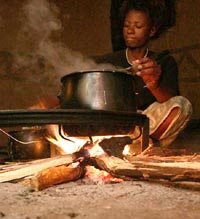Study: Soot is second major source of global warming
 Soot or black carbon from mud cooking stoves, used in tens of thousands of villages in India, are turning out to be one of the main causes of global warming - says one of the world's leading climate scientists, Veerabhadran Ramanathan. According to a study by Ramanathan, Soot, the second most pernicious gas, after carbon dioxide, is causing 18 percent of the global warming, while carbon dioxide is responsible for 40 percent of carbon dioxide.
Soot or black carbon from mud cooking stoves, used in tens of thousands of villages in India, are turning out to be one of the main causes of global warming - says one of the world's leading climate scientists, Veerabhadran Ramanathan. According to a study by Ramanathan, Soot, the second most pernicious gas, after carbon dioxide, is causing 18 percent of the global warming, while carbon dioxide is responsible for 40 percent of carbon dioxide.
Ramanathan, the climate science professor at the US Scripps Institute of Oceanography, working with The Energy and Resources Institute (TERI) in New Delhi, on a project to help poor Indian families acquire new environment friendly stoves, wandered through mud brick huts, containing mud cookstoves, releasing soot into the atmosphere. Ramanathan said, "It's hard to believe that this is what's melting the glaciers."
The study articulates that there are no cars and little electricity, emissions of carbon dioxide, the gas chiefly responsible for global warming, are almost zero, in Kohlua, in central India, but Soot is the major source of global warming there; if carbon dioxide is number one source of global warming, Soot is certainly number two.
According to the climate scientists, controlling the release of black carbon is quick and simple way to control the global warming. According to the scientists, it's like "low hanging fruit" that should be plucked as soon as possible to prevent the harsh consequences of global warming.
Ramanathan has suggested switching over from the primitive cooking stoves to modern versions that release far less soot. Ramanathan said, "It is clear to any person who cares about climate change that this will have a huge impact on the global environment."
The study states that Soot from India has been found in the Maldive islands and on the Tibetan Plateau; from the US, it travels to the Arctic. Ramanathan has warned that Himalayan glaciers are expected to lose 75pct of their ice by 2020.